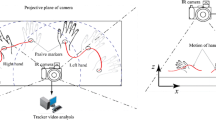Abstract
This manuscript presents a method for motion capture–based manufacturing time and motion studies. The proposed human motion analytics system uses motion capture technology to collect, transform, store, and analyze data from repetitive physical motions performed by manufacturing workers. The system supports the isolation of basic simple motions for analysis using statistical process control and data analytics techniques. The proposed method has resulted in the ability to identify patterns of repetitive motions and statistically significant deviations from those patterns.














Similar content being viewed by others
References
Taylor FW (1911) The principles of scientific management. Harper and Brothers, New York
Chaffin D, Martin B, Andersson G (2006) Occupational biomechanics. Wiley, Hoboken
Tilmanne J, d'Alessandro N (2015) Motion machine: a new framework for motion capture signal feature prototyping. 23rd European signal processing conference (EUSIPCO) in Nice, France, pp. 2401–2405
Yu Y, Li H, Yang X, Kong L, Luo X, Wong AY (2019) An automatic and non-invasive physical fatigue assessment method for construction workers. Autom Constr 103:1–12
Lopetegui M, Yen P, Lai A, Jeffries J, Embi P, Payne P (2014) Time motion studies in healthcare: what are we talking about? J Biomed Inform 49:292–299
Puthenveetil SC, Daphalapurkar CP, Zhu W, Leu MC, Liu XF, Gilpin-Mcminn JK, Snodgrass SD (2014) Computer-automated ergonomic analysis based on motion capture and assembly simulation. Virtual Reality 19:119–128
Sato N, Takahashi T, Tajima A, Odashima S, Suzuki J, Ishikawa T, Murata Y (2010) Improvement and its evaluation of worker's motion monitor system in automobile assembly factory. 2010 IEEE 24th international conference on advanced information networking and applications workshops in Perth, Australia, pp 899-904
Han W, Liu X, Radcliffe JH, Ghariban M, Wei J, Chung K C, Beling PA (2014) Analysis of manual manufacturing processes using motion sensing technologies. 2014 systems and information engineering design symposium (SIEDS) proceedings of the conference in Charlottesville, VA., IEEE, pp 244-249
Irwin E, Streilein K (2015) Use of field-based motion capture to augment observational data in ergonomic assessment of aircraft maintenance. Procedia Manuf 3:4501–4508
Faraway J, Reed MP (2007) Statistics for digital human motion modeling in ergonomics. Technometrics 49:277–290
van Andel CJ, Wolterbeek N, Doorenbosch CA, Veeger DH, Harlaar J (2008) Complete 3D kinematics of upper extremity functional tasks. Gait Posture 27:120–127
Sigal L, Balan ao, Black MJ (2009) HumanEva: synchronized video and Moton capture dataset and baseline algorithm for evaluation of articulated human motion. Int J Comput Vis 87:4–27
Giorgino T (2009) Computing and visualizing dynamic time warping alignments in R: the dtw package. J Stat Softw 31:1–24
Velichko VM, Zagoruyko NG (1970) Automatic recognition of 200 words. Int J Man-Mach Stud 2:223–234
Giorgino T, Tormene P (2009) Dtw: dynamic time warping algorithms. R package version 1.13-1, URL http://CRAN.R-project.org/package=dtw
Galili T (2015) Dendextend: an R package for visualizing, adjusting and comparing trees of hierarchical clustering. Bioinformatics 31:3718–3720
Forina M, Armanino C, Raggio V (2002) Clustering with dendrograms on interpretation variables. Anal Chim Acta 454:13–19
Williams N (2017) The Borg rating of perceived exertion (RPE) scale. Occup Med 67:404–405
Borg, GA (1982) Psychophysical bases of perceived exertion. Medicine & science in sports & exercise
Keogh E, Chu S, Hart D, Pazzani M (2004) Segmenting time series: a survey and novel approach. In Data mining in time series databases 1–21
Shewhart WA, Deming WE (1986) Statistical method from the viewpoint of quality control. Courier Corporation
R Core Team (2019) R: A language and environment for statistical computing. https://www.r-project.org.
Wickham H (2016) ggplot2: elegant graphics for data analysis. Springer-Verlag, New York
Scrucca L (2004) Qcc: an r package for quality control charting and statistical process control. R News 4:11–17
Murtagh F, Legendre P (2014) Ward’s hierarchical agglomerative clustering method: which algorithms implement Ward’s criterion? J Classif 31:274–295
Qualisys (2019) 5+, 6+ and 7+ series. https://www.qualisys.com/hardware/5-6-7/#!#tech-specs. Accessed 10 Nov 2019
Hexoskin (2019) Hexoskin Health Sensors & AI. https://www.hexoskin.com. Accessed 10 Nov 2019
Faundez-Zanuy M (2007) On-line signature recognition based on VQ-DTW. Recognition 40:981–992
Syeda-Mahmood T, Beymer D, Wang F (2007) Shape-based matching of ECG recordings. 29th annual international conference of the IEEE engineering in medicine and biology Society in Lyon, France, pp. 2012-2018
Huang B, Kinsner W (2002) ECG frame classification using dynamic time warping. Proceedings of the Canadian conference on electrical and computer engineering (IEEE CCECE 2002), 2:1105–1110
Snook SH, Ciriello VM (1991) The design of manual handling tasks: revised tables of maximum acceptable weights and forces. Ergonomics 34:1197–1213
Ciriello VM, Snook SH (1983) A study of size, distance, height, and frequency effects on manual handling tasks. Hum Factors 25:473–483
Funding
This study has been partially supported with funds provided by NEC Foundation of America from May 2016 until December 31, 2017.
Author information
Authors and Affiliations
Corresponding author
Additional information
Publisher’s note
Springer Nature remains neutral with regard to jurisdictional claims in published maps and institutional affiliations.
Rights and permissions
About this article
Cite this article
Wierschem, D.C., Jimenez, J.A. & Méndez Mediavilla, F.A. A motion capture system for the study of human manufacturing repetitive motions. Int J Adv Manuf Technol 110, 813–827 (2020). https://doi.org/10.1007/s00170-020-05822-9
Received:
Accepted:
Published:
Issue Date:
DOI: https://doi.org/10.1007/s00170-020-05822-9




